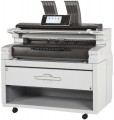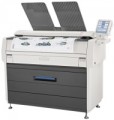Max resolution
The highest image resolution the plotter is capable of printing on paper. It is indicated by the number of dots per inch horizontally and vertically — for example, 1440x720.
The higher the resolution, the smoother the printed image will be as a result, the less noticeable individual dots will be on it (to the point that they cannot be seen at all with the naked eye). On the other hand, the ability to print in such resolutions affects the price of the plotter accordingly. In addition, do not forget that high-quality printing requires appropriate source materials — the quality of the print cannot be higher than the quality of the original image.
Note that in this case we are talking about the maximum resolution; usually in the settings it is possible to set more modest parameters.
Paper grammage (min)
The lowest grammage of paper that the plotter can print normally on. Grammage is expressed in grams per square metre; accordingly, the more dense the paper, the thicker it is, and the greater the difference between the minimum and maximum paper grammage, the greater the range of materials the plotter can operate with.
The use of materials that are too thin can lead to a number of troubles: multi-sheet picking, creasing, jamming, etc. Therefore, if you plan to use low-grammage paper, you should pay special attention to this characteristic.
Paper grammage (max)
The highest paper grammage that the plotter can handle normally. For details about grammage, see "Paper grammage (Min)"; and you should pay attention to its maximum value if you plan to use thick materials. Do not try to print on more dense media than it is specified in the specs of the device: even if the plotter can handle such paper normally, it can cause serious damage.
Data transfer
Data transfer supported by the plotter.
In addition to direct
connection to a PC via USB, supported by the vast majority of such devices, connection to PC network is very popular nowadays — usually via a wired
LAN port, and often via
Wi-Fi. The last one may additionally support special modes of operation —
Wi-Fi Direct and/or
. You can also find plotters with support of external media — in the form of a card reader or its own
USB port for flash drives.
Here is a more detailed description of each of these options:
— Connection to a PC (USB). Connecting to a standard USB port on a PC or laptop is a classic data transfer format found in almost all modern plotters. It allows you to send print tasks to the device, manage settings, receive various operation notifications on your PC, save digitized materials from the built-in scanner (if available — see above), etc. The disadvantages of this connection include the fact that it is designed for interaction between the plotter and only one specific PC. Anyway, you can also manage a network sharing on this PC — but this is quite complicated; it is easier to immediately select a device with network connectivity (see below).
— Network connection (LAN)
.... LAN connection via wired LAN interface. By itself, network connectivity at least makes the plotter accessible from any PC on the local network; and some models even allow to be used over the Internet. In addition, such devices may provide various specific network functions — for example, sending materials from a scanner to file storage or e-mail. A wired connection is not as convenient as Wi-Fi — in fact, because of the need to run a wire — but it is cheaper, and it also provides a more stable and reliable connection, not dependent on obstacles and interference levels near the device.
— USB (for flash drives). USB port for connecting various external media, installed in the plotter. In addition to flash drives, this connector can be used for external HDDs, as well as for cameras and many other portable devices with built-in storage. In any case, such a connection is mainly used for direct printing — sending files for printing without using a PC. And if you have a scanner (see above), you can also copy scanned materials to an external device via the USB port. Navigation through the contents of external media is usually carried out using the display installed on the plotter.
— Card reader. Built-in memory card reader — most often SD format (although specific types and volumes of supported cards should be clarified separately, since the SD standard covers several subspecies of media). The use of this function is generally similar to the USB port for flash drives described above — it makes it possible to print files directly from external media, as well as save data received from the scanner (if available) to this media. Memory cards are now supported in many types of electronic devices — in particular, laptops are almost always equipped with card readers, and in digital cameras this type of media is used as a standard for saving footage. Accordingly, the presence of a card reader in the plotter facilitates data exchange with such equipment: removing and inserting a card is often easier than copying materials to a computer or fiddling with a direct USB connection (if it is available at all).
— WiFi. The presence of its own Wi-Fi module allows the plotter to connect to PC network, as well as use special features such as Wi-Fi Direct and Airprint. See below for such features; as for the network connection, it provides all the same features as the wired LAN standard described above. At the same time, a Wi-Fi connection is much more convenient, as it allows you to do without laying cables. True, such a connection is somewhat more expensive, besides, the data transfer rate may drop with an abundance of interference; however, for plotters, the last one is most often not critical, and the price of a Wi-Fi module is often insignificant compared to the price of the entire device. So most modern network models support not only wired, but also wireless connections.
Specifications may also specify the Wi-Fi standard used by the device; most often it is Wi-Fi 4 or Wi-Fi 5. However, the difference between these standards in this case is not fundamental: both of them provide sufficient speed for functions implemented in plotters, and modern wireless equipment usually provides compatibility with all major Wi-Fi standards .
— WiFi Direct. A feature found on models with built-in Wi-Fi modules (see above). Direct support allows you to connect other Wi-Fi devices (laptops, smartphones, cameras, etc.) to such a plotter directly, without using a router and a local network. This can be especially convenient if there is no network equipment, or if it needs to be additionally configured. The set of functions available with this connection includes, at least, sending materials to print; however, control of plotter settings and other more specific features may also be provided.
— AirPrint. Wireless direct printing technology found on Apple devices such as iPhones, iPads, MacBooks, and more. AirPrint printing is convenient and simple—it requires no additional setup when connected to a plotter and can be done with just one touch ". In this case, communication with the printing device is carried out via Wi-Fi directly — similar to the Wi-Fi Direct described above (in fact, AirPrint is usually provided as an addition to this mode).Number of cartridges
The number of individual cartridges the plotter needs to operate.
Each cartridge is responsible for its base colour used in printing. Monochrome plotters (see "Output Type"), by definition, use only one cartridge, for black colour and for such devices this parameter is usually not specified at all. But in colour printing, where all available shades are obtained by mixing basic colours, the number of such colours (and, accordingly, cartridges) can be different.
The most modest of modern colour plotters are designed to work with
4 or 5 cartridges. The first option corresponds to the CMYK colour scheme with 4 basic colours — this is the minimum required for full colour printing. In turn, 5 cartridges usually mean a CMYK colour scheme, supplemented by a separate supply of black ink for monochrome images — this allows you not to waste consumables for such images that may be needed for colour prints, and also to print monochrome even with empty colour cartridges, and vice versa.
In general, these sets of basic colours are inexpensive, while they are able to provide fairly good quality prints; so plotters for 4 – 5 cartridges are very popular nowadays. However, the use of additional basic colours can significantly increase the quality of the image, primarily the reliability of colour reproduction. Thereby, advanced plotters can provide a larger number of cartridges —
6 – 10, and s
...ometimes more. Such devices are quite expensive and difficult to maintain, but they are indispensable for printing materials with high requirements of colour quality.Cartridge model
Models of cartridges used in the plotter. With this info, you can easily find original consumables for the device.
Built-in memory
The amount of built-in memory provided in the design of the plotter.
Such memory is used to store various service data: print tasks, settings profiles, etc. Due to this, the plotter becomes more "independent": for example, many models allow you to continue printing even when the master PC is turned off.
We emphasize that in this case we are talking about solid-state flash memory, which is used mainly for "operational" service information. The capacity of such memory is relatively low, it is measured in megabytes; but in addition to it, the design may include a larger storage capacity — usually a traditional hard drive. For more information about it, see "Drive Capacity".
Storage capacity
The capacity of
the built-in storage installed in the plotter.
First of all, we note that this drive should not be confused with the built-in memory (see above): in this case, we are talking about a storage designed for long-term storage of large amounts of data. Accordingly, such a storage differs from the mentioned memory in a larger capacity — its volume is already calculated in gigabytes. In addition, the built-in drive is usually a hard drive — this type of storage is better suited for the application described. Such a disk is intended mainly for storing various graphic files — footage, layouts for printing, data from a scanner (if available — see above), etc. The larger its volume, the more files can be simultaneously stored in the plotter's memory.
It is often more convenient to upload files into the device's memory in advance and send them to print directly from the control panel than to turn on the master PC every time — especially if you have to print often and a lot, and PCs are sometimes unavailable (for example, due to mismatched work schedules from printers and designers). On the other hand, such functionality is relevant mainly for powerful performant plotters, and the availability of a built-in drive significantly affects the cost. Therefore, this feature is found mainly in fairly advanced models.
Power consumption
Rated power consumption of the plotter. Usually specified by the maximum value — for the print mode, when the device requires the most power.
The heavier and more performant the device, the higher its power consumption in general. At the same time, models that are similar in performance may differ in this indicator. And here it is worth proceeding from the fact that a more energy-efficient unit usually costs more, but with intensive use, this difference can quickly pay off due to energy savings.
In addition, the power consumption may be necessary for special electrical calculations — for example, determining the necessary parameters of a voltage stabilizer, a backup generator, etc.

